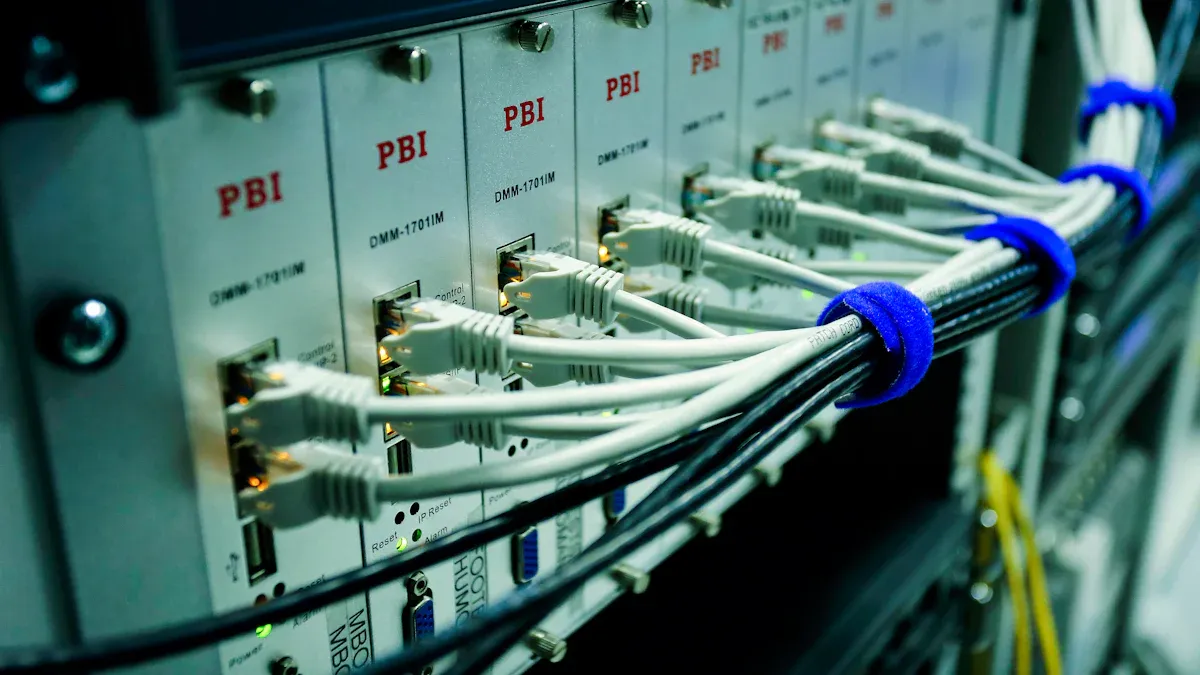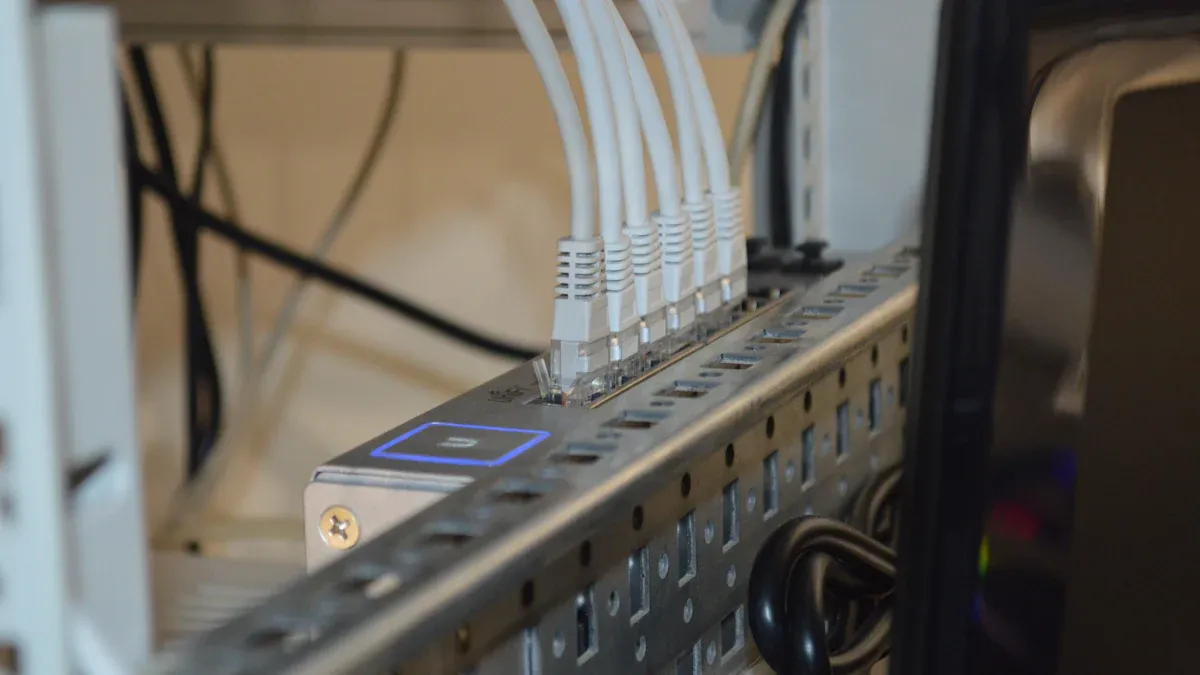ESTEL's Role in Shaping Telecom Inverter Advancements for IoT Integration

Telecom inverters are the backbone of modern IoT networks. They ensure uninterrupted power supply, enabling seamless communication between connected devices. As IoT adoption grows, the demand for advanced telecom inverter technology increases. You rely on these systems to maintain network stability and efficiency.
ESTEL leads the charge in addressing these challenges. With over a decade of industry expertise and a portfolio of 14+ products, ESTEL demonstrates its commitment to innovation. By staying ahead of emerging technology trends, it continues to redefine telecom infrastructure, empowering you to meet the demands of the digital age.
Key Takeaways
Telecom inverters help keep power steady in IoT networks. They ensure devices communicate without interruptions.
ESTEL creates new telecom inverter designs that save energy and work reliably.
New tech like 5G and edge computing is changing telecom systems. These need power solutions that are flexible and efficient.
Using energy management systems can lower costs and make telecom greener.
More IoT devices mean more need for telecom inverters to keep networks strong.
The Growing Demand for Telecom Inverter Technology

Impact of Emerging Technology Trends on Telecom Infrastructure
Emerging technology is reshaping the telecom landscape. The integration of 5G networks, artificial intelligence, and edge computing is driving significant changes in how telecom systems operate. These advancements enhance network capabilities, optimize performance, and improve service delivery. For instance, edge computing reduces latency by processing data closer to its source, ensuring faster and more reliable connectivity.
The telecom sector is also experiencing rapid growth. Global spending is projected to reach $1.536 trillion in 2024, marking a 7.8% increase from 2022. This growth reflects the increasing demand for advanced telecom technology to support IoT networks and other digital innovations.
Insight | Description |
|---|---|
1 | Telecom is experiencing transformative changes due to technological advancements. |
2 | Data analytics is crucial for optimizing performance in telecom. |
3 | The integration of AI is enhancing network capabilities. |
4 | 5G technology is reshaping operational strategies. |
5 | Edge computing is vital for improving service delivery. |
Challenges in Energy Efficiency, Scalability, and Reliability
Telecom inverters face several challenges in meeting the demands of modern connectivity and telecom systems. Limited installation space often restricts the deployment of larger systems. High efficiency in power delivery is essential to reduce energy costs and environmental impact. Effective load management becomes critical as networks expand, ensuring consistent performance under varying conditions.
Predictive maintenance systems are another necessity. They help identify potential issues before they disrupt operations, enhancing reliability. Solutions like the NetSure Inverter System address these challenges by offering compact designs with energy efficiencies of up to 95.2%. This reduces electricity costs and greenhouse gas emissions while ensuring zero transfer time from grid to battery, improving overall system reliability.
Role of Telecom Inverters in Supporting IoT Networks
Telecom inverters play a crucial role in maintaining the stability of IoT networks. They ensure a seamless power supply, enabling uninterrupted communication between connected devices. As IoT adoption grows, the demand for reliable inverters increases. These systems support the integration of renewable energy sources, such as solar and wind power, by converting DC electricity to AC.
Additionally, telecom inverters are vital for expanding connectivity in remote areas. They provide dependable power solutions for telecom equipment, ensuring consistent performance even in challenging environments. By addressing energy efficiency, scalability, and reliability, telecom inverters empower you to build robust IoT networks that meet the demands of modern technology.
ESTEL's Innovations in Telecom Inverter Technology
Advanced Designs for IoT Integration
ESTEL has revolutionized telecom inverter technology by introducing advanced designs tailored for IoT integration. These designs prioritize seamless connectivity, ensuring that IoT devices operate efficiently within telecommunications networks. Smart inverters equipped with IoT capabilities are at the forefront of this transformation. They enable real-time monitoring of critical performance metrics such as voltage, current, and temperature. This proactive approach allows you to detect potential issues early, reducing downtime and enhancing system reliability.
Key features of ESTEL's advanced designs include:
IoT-enabled rectifiers for real-time performance tracking.
Automated alerts for deviations from optimal performance.
Intelligent actions to maintain system stability.
These innovations not only improve the lifespan of telecom inverters but also align with emerging telecommunication trends. By integrating IoT technology, ESTEL ensures that its solutions remain adaptable to the evolving demands of ultra-high-speed broadband and digital transformation.
Energy Management Systems for Enhanced Efficiency
Energy efficiency is a cornerstone of ESTEL's telecom inverter solutions. The company has developed cutting-edge energy management systems that optimize power usage while minimizing waste. These systems are designed to address the growing need for sustainable and cost-effective telecommunications infrastructure.
Metric | Description |
|---|---|
Early problem detection prevents downtime, ensuring uninterrupted service. | |
Better maintenance | Enhanced monitoring improves equipment performance and longevity. |
Manage renewable energy | Efficiently integrates solar and wind power into telecom networks. |
Boost power distribution efficiency | Reduces energy costs by optimizing Power Usage Effectiveness (PUE). |
Fair energy billing | Accurate energy measurement supports fair billing and resource planning. |
ESTEL's energy management systems achieve energy efficiencies exceeding 96%, significantly lowering operational costs. For example, real-time monitoring in data centers has led to energy savings of up to 41%, as demonstrated by organizations like the U.S. General Services Administration. These systems not only reduce costs but also support the future of sustainable telecommunications by integrating renewable energy sources.
Real-World Applications of ESTEL's Solutions
ESTEL's telecom inverter solutions have proven their effectiveness in real-world scenarios. From performance management to infrastructure optimization, these systems consistently meet the demands of modern telecommunications.
Case Study Description | Key Findings |
|---|---|
Performance Management | ESTEL systems meet technical benchmarks, ensuring smooth operations. |
Infrastructure Management | Robust designs reduce project delivery challenges and maintain efficiency. |
For example, ESTEL's smart inverters play a crucial role in managing distributed energy resources (DERs). They ensure grid stability while supporting the integration of renewable energy. These solutions are particularly valuable in remote areas, where reliable power supply is essential for expanding broadband access. By addressing the challenges of scalability and reliability, ESTEL empowers you to build robust networks that align with emerging telecommunication trends.
IoT Integration and Emerging Telecommunication Trends

Seamless Connectivity Across IoT Devices
The rapid expansion of IoT devices demands seamless connectivity to ensure efficient communication across networks. By 2025, over 75 billion connected devices will drive a $1.1 trillion revolution across industries. This growth highlights the need for robust integration strategies to manage the complexity and scale of operations effectively.
Telecom inverters play a pivotal role in maintaining uninterrupted power supply, enabling faster wireless connectivity between devices. Advanced telecommunications systems, such as IoT-enabled rectifiers, enhance connectivity by reducing downtime through live monitoring and smart maintenance. These systems ensure that your IoT devices remain operational even during power fluctuations, supporting ultra-high-speed broadband and digital transformation initiatives.
Statistic Description | Value | Year |
|---|---|---|
Connected IoT devices | Over 75 billion | 2025 |
Data generated by IoT devices | 79.4 zettabytes | 2025 |
Global IoT market size | USD 300.3 billion to USD 650.5 billion | 2021 to 2026 |
CAGR of IoT market | 16.7% | 2021 to 2026 |
These trends underscore the importance of seamless connectivity in telecommunications networks. By leveraging innovative telecom inverter technology, you can build systems that support the growing demands of IoT devices while ensuring reliable performance.
Supporting Edge Computing and Reducing Latency
Edge computing is transforming telecommunications by processing data closer to its source, reducing latency and improving responsiveness. This approach is essential for IoT applications that require real-time data analysis and decision-making. High-efficiency rectifiers, achieving up to 96.5% efficiency, minimize energy waste while supporting edge computing infrastructure.
Switching to these rectifiers can save over $7,000 annually for every 1000A at $0.3/kWh. Upgraded telecom structures also save up to 20% more energy yearly, making them cost-effective and environmentally friendly. IoT-enabled rectifiers further enhance edge computing by reducing downtime by 30% through live monitoring and smart maintenance.
Tip: Investing in advanced telecom inverter systems not only reduces latency but also ensures faster wireless connectivity for IoT devices, enabling smoother operations and better user experiences.
By supporting edge computing, telecom networks can handle the increasing data traffic generated by IoT devices. This approach strengthens your infrastructure, ensuring that your systems remain scalable and adaptable to future demands.
Strengthening Networks for Future IoT Growth
The future of IoT depends on robust telecommunications networks that can handle increasing device connectivity and data traffic. Quality of Service (QoS) metrics, such as reliability, energy consumption, and availability, are crucial for evaluating the performance of IoT systems. Scalability ensures that new devices can be added without degrading network performance, which is essential for future growth.
Bandwidth utilization, latency, and packet loss are key indicators of network capacity. Efficient telecom inverter systems optimize these metrics, ensuring that your networks remain reliable and responsive. For example:
Bandwidth utilization helps you understand how much of your network capacity is being used.
Latency measures the delay in data transmission, affecting the responsiveness of IoT applications.
Packet loss indicates the reliability of your network, as lost packets can degrade service quality.
By addressing these factors, you can strengthen your telecommunications infrastructure to support the growing demands of IoT. Advanced telecom inverter technology ensures that your networks remain scalable, reliable, and ready for the digital transformation ahead.
Sustainability and Future Trends in Telecom Inverters
Energy-Efficient and Eco-Friendly Solutions
Sustainability is becoming a cornerstone of telecommunications infrastructure. Energy-efficient telecom inverter designs are leading the way in reducing environmental impact while maintaining high performance. For example, integrating Proton Exchange Membrane Fuel Cells (PEMFCs) with advanced optimization algorithms has improved reliability and reduced costs. This innovation addresses power supply challenges and contributes to a greener future.
Surge Protective Devices (SPDs) also play a vital role in sustainable technology solutions. These devices protect equipment, reduce electronic waste, and enhance energy efficiency. By minimizing carbon footprints, SPDs help establish eco-friendly power systems that align with global sustainability goals.
The performance of energy-efficient telecom inverters is impressive. Rectifiers and inverters achieve efficiencies exceeding 96%, while substation converters reach over 97% at maximum power. These advancements reduce energy loss and operational costs. Additionally, patented zero-voltage switching technology enhances energy conversion, ensuring reliable performance for over 15 years.
Metric | Value |
|---|---|
Energy Efficiency (Rectifier) | Exceeds 96% |
Substation Converter Efficiency | Over 97% at max power |
Power Density Improvement | 10% better than discrete solutions |
Package Inductance Reduction | 16% reduction |
By adopting these solutions, you can reduce energy consumption and cooling system needs, paving the way for sustainable telecommunications infrastructure.
Adapting to Network Virtualization and Disaggregation
Telecommunications networks are undergoing a digital transformation, driven by trends like 5G technology and fiber-to-the-home broadband. Network virtualization and disaggregation are reshaping how telecom systems operate. Virtualization separates hardware from software, enabling flexible and scalable network management. Disaggregation breaks down traditional systems into modular components, allowing you to optimize performance and reduce costs.
Telecom inverter technology is adapting to these changes. High-efficiency designs support virtualized networks by ensuring reliable power delivery to modular components. For example, energy-efficient inverters with power factors greater than 0.98 enhance grid stability and energy utilization. These systems also reduce latency, supporting real-time applications like edge computing and IoT.
Future trends indicate significant growth in sustainable telecom solutions. By 2032, the market size for telecom inverters is projected to reach USD 9,531.98 million, with a compound annual growth rate (CAGR) of 7.6%. Data center capacity is expected to increase from 60 GW in 2020 to as much as 219 GW by 2030.
Year | Market Size (USD Million) | CAGR (%) |
|---|---|---|
2024 | 5,305 | - |
2032 | 9,531.98 | 7.6 |
Year | Data Center Capacity (GW) |
|---|---|
2020 | 60 |
2030 | 171 - 219 |
These trends highlight the importance of adapting telecom infrastructure to meet future demands. By leveraging energy-efficient and modular telecom inverter designs, you can build networks that support digital transformation and sustainable growth.
ESTEL continues to lead the way in advancing telecom inverter technology, delivering solutions that prioritize efficiency, reliability, and scalability. These innovations empower you to build robust IoT networks while addressing the challenges of modern telecommunications.
Metric | Description |
|---|---|
Efficiency | Indicates the effectiveness of the rectifier in converting input power. |
Reliability | Evaluates the dependability of the rectifier under various conditions. |
Power Density | Reflects the power output relative to the rectifier's size, saving space. |
By integrating cutting-edge technologies like CoolGaN™ and SiC, ESTEL ensures superior performance. CoolGaN™ achieves over 99% efficiency at 50% load, offering unmatched energy savings and reliability.
Future trends, such as 6G technology, promise faster wireless connectivity with speeds up to ~1 Tb/sec. These advancements will enhance user experiences and support sustainable telecom infrastructure.
ESTEL’s commitment to sustainability and innovation positions you to meet the demands of tomorrow’s telecommunications landscape confidently. 🌍
FAQ
What role do telecom inverters play in 5G networks?
Telecom inverters ensure uninterrupted power for 5G infrastructure. They maintain stable energy flow, enabling high-speed connectivity and reliable communication. These systems also support the integration of renewable energy, reducing operational costs and environmental impact.
How does 6G technology differ from 5G?
6G technology promises faster speeds, lower latency, and enhanced AI for network optimization. While 5G focuses on high-speed connectivity, 6G will enable next-generation networks with capabilities like real-time holographic communication and advanced IoT applications.
Why is energy efficiency important in telecom networks?
Energy efficiency reduces operational costs and environmental impact. Efficient telecom inverters optimize power usage, ensuring reliable performance while minimizing waste. This is crucial for supporting next-generation networks and sustainable growth.
How do telecom inverters support edge computing?
Telecom inverters provide stable power for edge computing infrastructure. They reduce latency by processing data closer to its source, ensuring faster response times. This is essential for IoT applications and high-speed connectivity in modern networks.
What advancements are expected in next-generation networks?
Next-generation networks will integrate AI for network optimization, 6G technology, and modular designs. These advancements will enhance scalability, reliability, and energy efficiency, supporting future demands for high-speed connectivity and IoT growth.
See Also
Essential Insights Into Telecom Power Supply Characteristics
Innovative Energy Storage Solutions for ESTEL Telecom Cabinets
Understanding the Power System of ESTEL Telecom Cabinets
CALL US DIRECTLY
86-13752765943
3A-8, SHUIWAN 1979 SQUARE (PHASE II), NO.111, TAIZI ROAD,SHUIWAN COMMUNITY, ZHAOSHANG STREET, NANSHAN DISTRICT, SHENZHEN, GUANGDONG, CHINA

